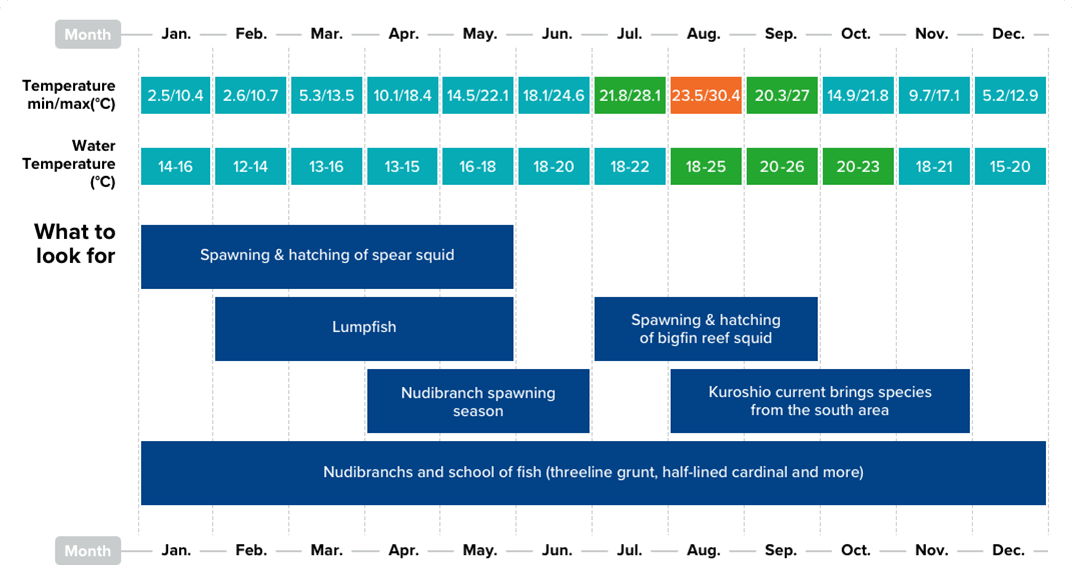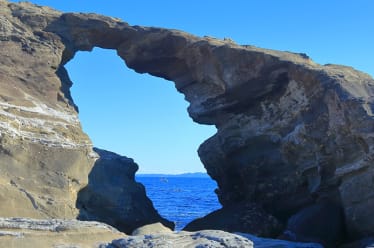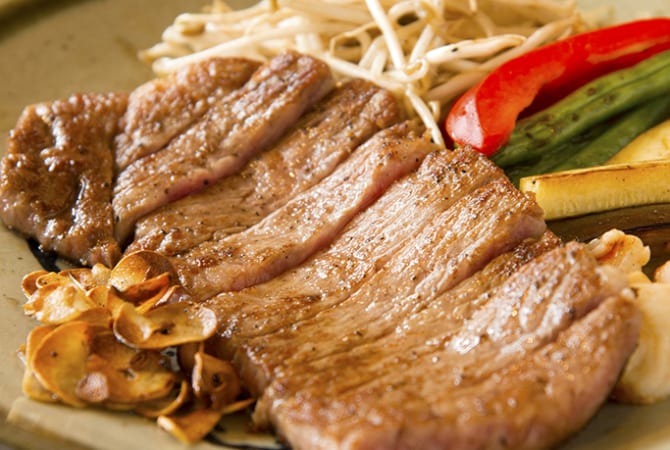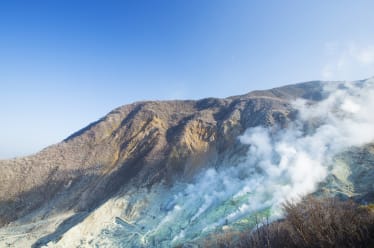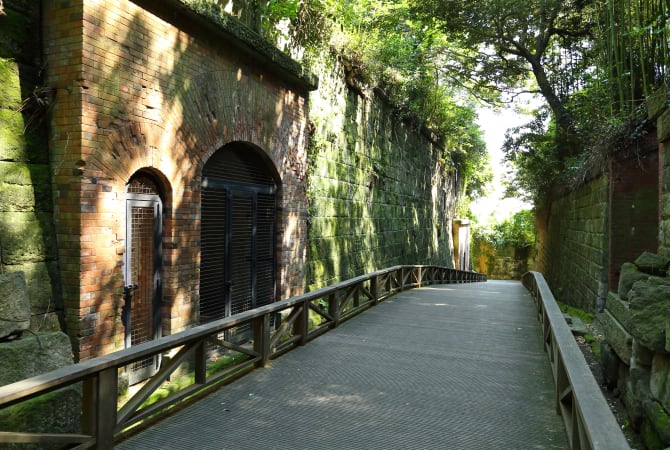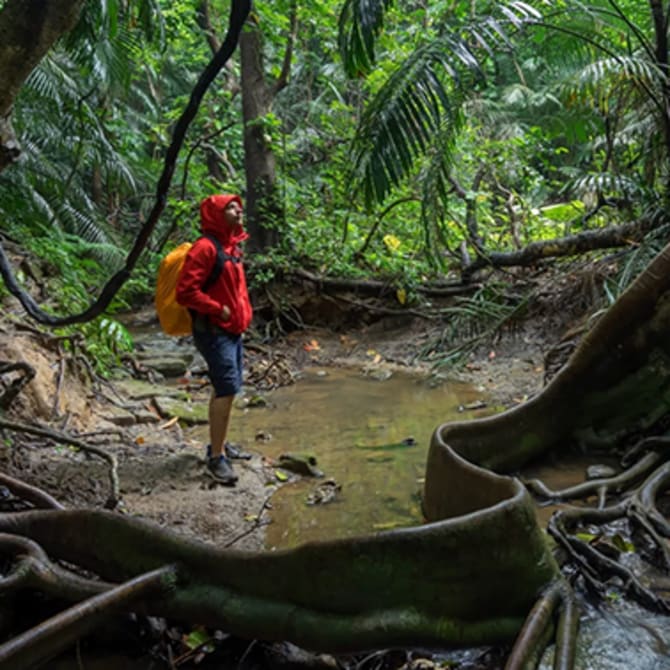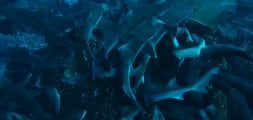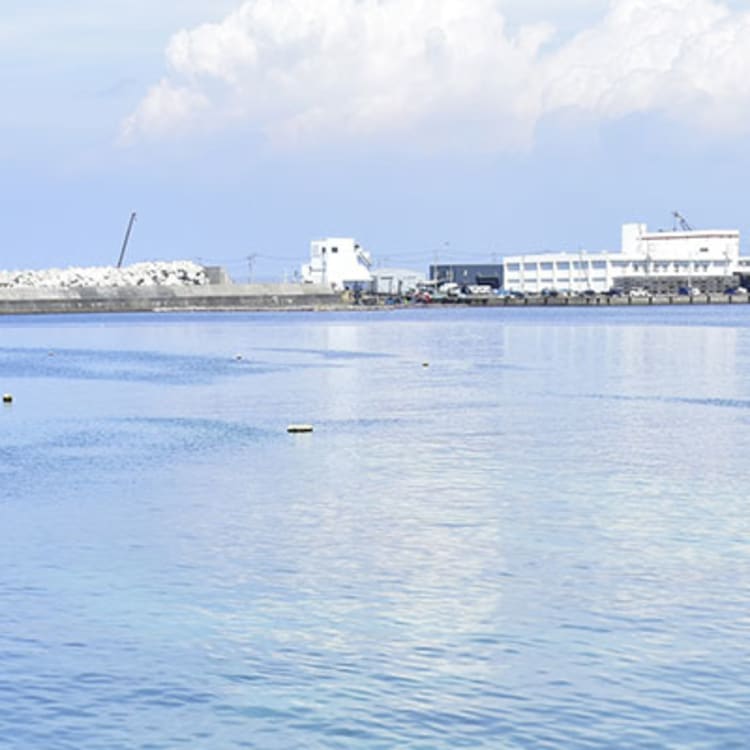
Kanagawa Diving Guide
There is a lot to do on land in Kanagawa Prefecture, from visiting the famous port city of Yokohama to enjoying hot springs with a view of Mt. Fuji in Hakone, to walking through the beautiful historic city of Kamakura. But Kanagawa also holds a beautiful underwater world for divers to explore! Kanagawa’s Sagami Bay, also known as the “Treasure House of Nudibranchs,” located between the tip of Miura Peninsula on the east and Cape Manazuru on the southwest, is excellent for macro diving, offering not just an abundance of nudibranchs but also lumpfish, blenny, and frogfish.
Kanagawa offers some of the closest dive destinations from Tokyo; even the farthest dive site is less than 1.5 hours away by train.
What you can see
Kanagawa is a nudibranch paradise! Video taken in Jogashima.





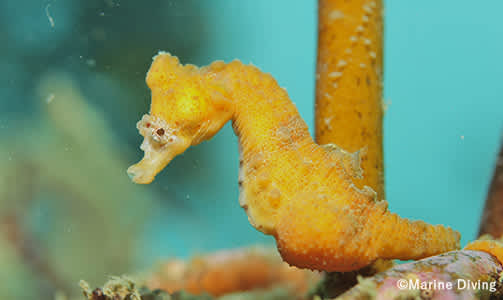
Season Calendar for Divers
Miura Peninsula
MIYAGAWA BAY
Located at the tip of the Miura Peninsula, Miyagawa Bay is located at the intersection of Sagami Bay and Tokyo Bay, two of the largest bays in Japan. These nutrient-rich waters have led to uniquely dynamic seascapes and unusually large fish. Miyagawa Bay boasts four boat dive sites and one shore dive site. Boat dive sites Kasagone and Tobine offer many chances to see a wide range of marine life like Sindo’s seahorse and the fringehead blenny, as well as many fish from the warm, tropical waters of the south, such as juvenile cube trunkfish, ghost pipefish, and warty frogfish.

JOGASHIMA
Jogashima is a small island at the tip of the Miura Peninsula, easily accessible by bridge. It is famous for its dynamic walls and overhangs, as well as the beautiful nudibranchs that can be seen there. Boat dive site Iwabone boasts rock layers well worth seeing. At Heibune, another boat dive site, you can sometimes see 30 to 40 different kinds of nudibranchs in a single dive.
Located between Sagami and Tokyo Bay, the marine ecosystem is quite similar to that of Miyagawa bay. However, Jogashima is also directly hit by the Kuroshio Current, which carries pelagic fish to the island in addition to the tropical fish carried from the south.

Shonan Area
HAYAMA
Hayama has been a protected natural reserve since 1995 for its biologically diverse ecosystem. It is especially famous for lumpfish, which appear from February to May. You may also see many kinds of blenny (fringehead blenny being the most popular), nudibranchs, and more! Swimming through the seaweed jungle during the winter is also fun.

ENOSHIMA
Enoshima is a small island that is very popular for marine activities; you will see people enjoying surfing, windsurfing, and SUP all year long. Once in the water, you will find an astounding number of nudibranchs at any of Enoshima’s dive sites, but Maruyama, a boat dive site, offers one of the best sites.

Seisho Area
HAYAKAWA
A calm dive site that is great for beginners. The Kuroshio Current into Sagami Bay brings many kinds of tropical fish from the south to Hayakawa. At Hayakawa Beach, a shore dive site, divers can see flatfish such as flounders and soles, red frog crab, and frogfish. Lumpfish also appear from winter to spring. Boat dive sites offer the stunningly beautiful sight of colorful soft corals blooming everywhere.

ISHIBASHI
A calm shore dive site that is fun year-round and perfect for beginners. Like other dive sites in Kanagawa, Ishibashi is rich in macro life; Sindo’s seahorse, frogfish, pineapple fish, squat shrimp, and nudibranchs are among the creatures that can be commonly seen. Juvenile lumpfish appear in the winter, and schools of Schooling Bannerfish appear beginning in late summer.

NEBUKAWA

Shiretoko Peninsula, located in the Sea of Okhotsk, is famous for drift ice diving and its status as a Natural World Heritage site. The area’s ice originates at the Amur River in Russia and is carried down south to the Shiretoko area, where the drift ice lasts longer than anywhere else in Hokkaido. The drift ice diving season starts in February every year when the ice arrives. The water may be very cold, but the world under the drifting ice is a memorable sight.
If you’re lucky, you may encounter the natural seal during your dive in this beautiful ocean. After diving, you can enjoy local delights, such as the famous hot springs at Utoro and tasty seafood dishes.
IWA
Iwa has four boat dive sites. Iwa’s dynamic seascapes set it apart from other dive sites in the Seisho area. At the boat dive site of Bakene, soft corals and large schools of scalefin fairy basslet and damselfish come together to create beautiful scenery. At Iwa Beach, you have a chance of seeing juvenile lumpfish from winter to spring and the spawning of bigfin reef squid during summer. Pelagic fish such as greater amberjack also appear from time to time.

FUKUURA
The westernmost dive site in Kanagawa, offering large colonies of bubble-tip anemone in Fukuura that are definitely worth seeing. Little Shark is a fun boat dive site where you can often see juvenile bullhead sharks. During summer, there is even a chance of encountering sea turtles and Japanese eagle rays.
How to get there
The dive sites of Kanagawa are the quickest to reach from Tokyo. From Shinawaga Station, you only need an hour, thanks to the Shinkansen bullet train, to reach Hayakawa. Underwater visibility is lower than that of the Izu Peninsula or the Izu Islands, but if you enjoy macro diving and muck diving, you will enjoy diving in Kanagawa.




















































